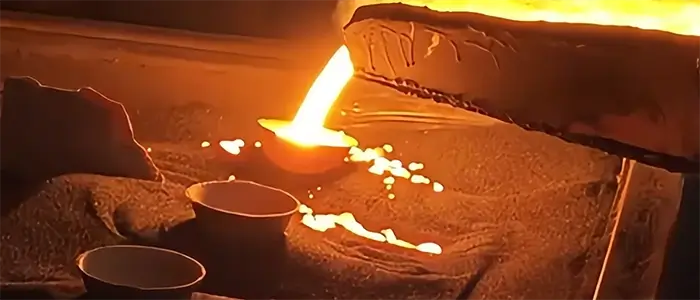In my time working with foundries and designing casting processes, I’ve learned that the gating system is arguably the most critical part of the mold. It’s not just a passage for metal; it’s a carefully engineered hydraulic system that determines the very quality of the final casting. Get it wrong, and you’ll be dealing with a world of defects. Get it right, and you achieve a clean, sound, and profitable part.
Simply put, the gating system is the network of channels that guides molten metal from the pouring cup (where you pour the metal) into the mold cavity (the shape of the final part).
The Key Components of Gate System in Casting
A well-designed gating system isn’t a single channel; it’s a series of components, each with a specific job. I always think of them as a relay team, passing the molten metal baton smoothly to the finish line.
Pouring Cup / Basin: This is the entry point. My main goal here is to control the pour. A proper basin helps reduce turbulence and prevents slag and oxides from being drawn into the mold. It’s the first, and often most overlooked, line of defense.
Downsprue (or Sprue): This is the vertical channel from the basin down into the mold. From experience, the key here is taper. A tapered sprue (wider at the top, narrower at the bottom) is absolutely non-negotiable. Why? Because it prevents aspiration—a phenomenon where a low-pressure area forms and literally sucks air and sand gases into the metal stream. I’ve seen more porous castings from an un-tapered sprue than almost any other cause.
Sprue Well: This is a small pool or reservoir at the base of the downsprue. Its job is to absorb the initial impact and energy of the falling metal, reducing turbulence before the flow moves horizontally. I think of it as a shock absorber for the melt.
Runners: These are the horizontal channels that distribute the metal from the sprue well towards the mold cavity. In larger castings, I often use a runner system that branches out to feed different sections evenly.
Gates: These are the final, carefully controlled inlets that connect the runner to the mold cavity itself. This is where precision is paramount. The gate’s cross-section is designed to:
-
-
Control the flow rate.
-
Act as a “skim gate” to trap any remaining oxides in the runner.
-
Be small enough to allow for easy removal (breaking off) from the finished casting without damaging it.
-
Risers (or Feeders): While technically a separate system, risers are the inseparable partner of the gating system. They are reservoirs of molten metal that feed the casting as it solidifies and shrinks, preventing shrinkage cavities (like sink marks). Placing them correctly is a science in itself.
The Core Principles of Gate System in Casting:
Designing a gating system isn’t guesswork; it’s based on fundamental principles of fluid dynamics and heat transfer.
-
Minimize Turbulence: This is rule number one. Turbulent flow incorporates air (oxide formation) and erodes the mold wall, causing sand inclusions. I achieve this through tapered sprues, proper sprue wells, and appropriately sized channels.
-
Prevent Air Entrapment: As mentioned, this is achieved primarily by using a tapered sprue to maintain a “choke” effect and ensure all passages are full, preventing a vacuum.
-
Regulate Solidification: The entire system, especially the risers, must be designed to promote directional solidification. The molten metal in the riser must be the last to solidify, continuously feeding liquid metal into the casting to compensate for shrinkage. I often use Chvorinov’s Rule (solidification time is proportional to the square of the volume-to-surface-area ratio) to design risers that are larger and solidify slower than the casting.
-
Trap Slag and Impurities: A well-designed system uses the geometry of the runners and gates to trap less dense slag and oxides in the channels, preventing them from entering the cavity. This is often done by having the gate enter the cavity from the bottom.
Common Gating System Types:
-
Vertical Gating: Simple, where metal flows straight down a sprue into the cavity. Rarely ideal due to high turbulence.
-
Horizontal Gating: Common in sand casting. Metal flows down the sprue and then horizontally through runners and gates.
-
Bottom Gating: The gates enter the mold cavity from the bottom. This is my preferred method for minimizing turbulence and oxidation, as it gently fills the mold from the bottom up. The metal rise is calm and controlled.
-
Top Gating: Gates enter from the top. While simple, it’s highly turbulent as the metal falls and splashes inside the cavity. I only use this for very simple, robust shapes where surface quality isn’t critical.
Common Defects from Poor Gating:
I’ve debugged enough casting defects to know their root causes intimately. A bad gating system is responsible for most of them:
-
Shrinkage Cavities: Caused by inadequate feeding (poor riser design or placement).
-
Misruns & Cold Shuts: The metal solidifies before filling the cavity. This tells me the gates were too small, the metal was too cold, or the pour was too slow.
-
Sand Inclusions: Molten metal erodes the mold wall due to excessively high velocity or turbulent flow.
-
Gas Porosity (Blowholes, Pinholes): Caused by air being aspirated into the flow or gases from the mold not being able to escape.
-
Oxide Inclusions: Turbulence folds oxides into the metal stream, creating weak points in the final casting.
In summary, from my experience, the gating system is the unsung hero of casting. It’s a complex puzzle where fluid dynamics, heat transfer, and practical foundry knowledge intersect. A beautifully patterned mold is useless without a properly designed system to fill it. The time I invest in meticulously designing and calculating the gating system always pays back tenfold in higher quality, fewer rejects, and a smoother production run. It’s the blueprint for success.


